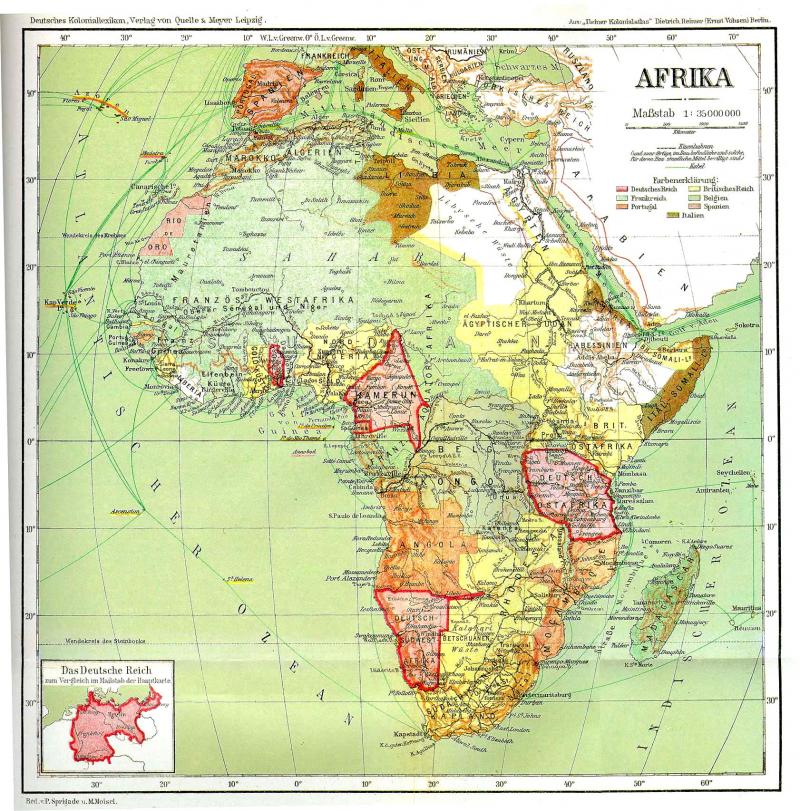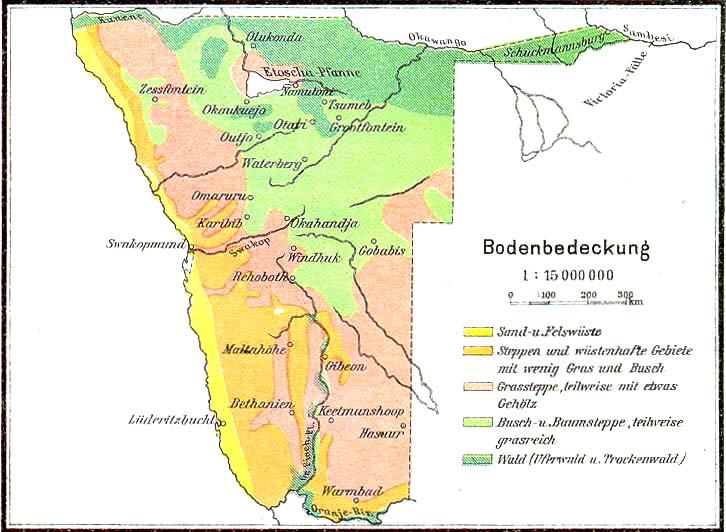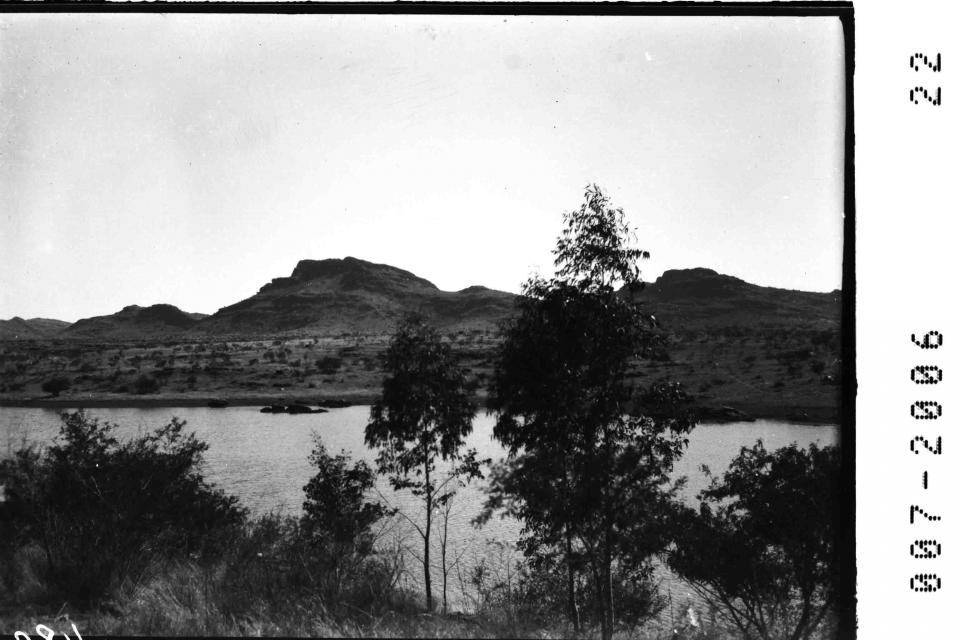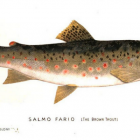
African colonies (Koloniallexion, Bildarchiv der Deutschen Kolonialgesellschaft, Universitätsbibliothek Frankfurt am Main)
African colonies (Koloniallexion, Bildarchiv der Deutschen Kolonialgesellschaft, Universitätsbibliothek Frankfurt am Main)
This image is from the Koloniallexion, Bildarchiv der Deutschen Kolonialgesellschaft, Universitätsbibliothek Frankfurt am Main). Deutsches Kolonial-Lexikon, edited by Heinrich Schnee. Leipzig: Quelle & Meyer, 1920. Three volumes. Click here to view source.
This work is used by permission of the copyright holder.
The transaction took place on 11 March 1909. That day, the Kassler Fishing Club handed a German colonial official only identified as Dr. v. E. (probably Dr. Max von Eschtruth) an ominous package. He had been on vacation in Germany. Now, he was about to return to Southwest Africa, a German colony originally founded in 1884. In Antwerp, Belgium, he received an unusual delivery: thousands of brown trout (Salmo trutta fario) eggs. The precious cargo had come from a well-known fish-breeding institution in Saxony, central Germany, and given its destination more than 6,000 nautical miles (ca. 11,100 kilometers) away, had been carefully packed in ice and covered with cloth. Once aboard, it was stored so as to avoid it being exposed to temperatures above 10°C. It was a long journey, three weeks at sea, through the English Channel, to Las Palmas, and finally to Swakopmund. There, the cargo was repackaged into a small ice box surrounded by two other boxes. After three days by train it arrived in Grootfontein, in central Namibia. According to the Windhuker Nachrichten newspaper, only around two hundred eggs had not survived the long journey. The rest were quickly unpacked and put into a nearby stream. There, many trout eggs stopped moving, and by the next day all were dead: the shock of simply releasing them into 21°C warm water had killed them (Allgemeine Fischerei-Zeitung, 1 May 1910; Windhuker Nachrichten, 30 July 1910).

The landscape of German Southwest Africa (Koloniallexion, Bildarchiv der Deutschen Kolonialgesellschaft, Universitätsbibliothek Frankfurt am Main)
The landscape of German Southwest Africa (Koloniallexion, Bildarchiv der Deutschen Kolonialgesellschaft, Universitätsbibliothek Frankfurt am Main)
This image is from the Koloniallexion, Bildarchiv der Deutschen Kolonialgesellschaft, Universitätsbibliothek Frankfurt am Main. Deutsches Kolonial-Lexikon, edited by Heinrich Schnee. Leipzig: Quelle & Meyer, 1920. Three volumes. Click here to view source.
This work is used by permission of the copyright holder.
Part of broader efforts to settle German Southwest Africa, the introduction of fish farming had begun prior to this episode, and against many odds. A variety of experts, increasingly part of the colonial administration, had long planned wells and dams in light of their desires to turn the arid landscapes of Southwest Africa into self-sustaining agricultural settler environments. Countless expeditions had explored and surveyed the area, or had visited neighboring South Africa to learn from the British. Within these contexts different voices soon pointed to the possible introduction of German fish. In 1904, one observer highlighted two main challenges: “For the breeding of trout and carp, […] the establishment of better water conditions has to be completed first. Plus, it would not be easy to transport stock and seed fish” to German Southwest Africa (Rode, “Südwestafrika,” 754).
Colonialists felt they could confront both issues with an increasing investment in and the construction of colonial infrastructures. In 1903, the completed Mole harbor in Swakopmund allowed settlers to disembark much more easily. Newcomers could also travel by train inland—a much simpler journey compared to relying on oxen wagons. Additionally, the colonial administration offered numerous incentives to settlers, including loans. Soon new arrivals began pouring into the colony, especially after the German defeat of the Herero and Nama people in what has been rightfully called “the first genocide of the twentieth century.”

Neudamm in German Southwest Africa in 1914
Neudamm in German Southwest Africa in 1914
This image shows Neudamm. No. 007-2006-22, 1914, Bildarchiv der Deutschen Kolonialgesellschaft, Universitätsbibliothek Frankfurt am Main. The image can be found on this website, when searching “Neudamm.”
This work is used by permission of the copyright holder.
Early efforts to introduce German fish took shape within these contexts. In fact, in September 1904, the district commander of Windhoek, Max von Eschstruth, tried to introduce carp into an artificial pond. He intended for the pond to become part of an agricultural experiment station, which was established in Neudamm five years later and for which he had planned to acquire carp and tench from the consulate in Cape Town. There, and elsewhere in their colonial empire, British efforts had been much more advanced and successful, as outlined in the historiography already. However, Eschstruth was only able to get his hands on 50 carp from an institution in Jonkershoek (Fischerei-Zeitung, 11 August 1906). That cargo was then transported by ship to Swakopmund, later by train to Windhoek—and for the last 35 kilometers a Herero worker had to carry it. Luckily, there were no losses and local efforts to control herons and other predators were ultimately successful.

Adult trout can withstand temperatures of up to 25°C; however, their eggs die if temperatures rise above 16°C—a problem given climatic circumstances in Southwest Africa.
Adult trout can withstand temperatures of up to 25°C; however, their eggs die if temperatures rise above 16°C—a problem given climatic circumstances in Southwest Africa.
Bachforelle (brown trout) drawn by Dumaresq Manning in Trout Fishing in the Cape Colony, 1908. Click here to view Google Play source.
 This work is licensed under a Creative Commons Public Domain Mark 1.0 License.
This work is licensed under a Creative Commons Public Domain Mark 1.0 License.
Such early triumphs soon encouraged the naturalization of trout, with additional attempts in 1911. That time “roughly 1,000 eggs were still alive” at arrival in Grootfontein (Südwestbote, 25 February 1911). The fish even hatched, and swam into the artificial pond. Yet once again the water temperature reached more than 20°C that afternoon—which killed the trout. Utopian expectations did not match realities on the ground.
Over time, German colonial fantasies tied to the introduction of trout began to fade. In 1911, newspapers like the Südwestbote had still been defiant; three years later, the Deutsches Kolonial-Lexikon painted a different picture: “Within German colonies the artificial breeding of Cypriniformes is probably not possible at all” (636). And although references jealously pointed to British successes nearby (649), the publication concluded that the breeding of Salmonidae would only be promising in more mountainous areas. Since those environments did not exist in Southwest Africa, future efforts were to be “based on transplantation and breeding of native fishes” (636). In that sense, German colonial hubris, irritated by the stark realities of a hostile colonial nature, had seemingly learned its lessons.
How to cite
Kalb, Martin. “Naturalizing Trout? Fish Farming in German Southwest Africa.” Environment & Society Portal, Arcadia (Autumn 2017), no. 33. Rachel Carson Center for Environment and Society. doi.org/10.5282/rcc/8158.
ISSN 2199-3408
Environment & Society Portal, Arcadia
 This work is licensed under a Creative Commons Attribution 4.0 International License.
This work is licensed under a Creative Commons Attribution 4.0 International License.
2017 Martin Kalb
This refers only to the text and does not include any image rights.
Please click on an image to view its individual rights status.
- Brown, Duncan. Are Trout South African? Stories of Fish, Peoples and Places. Johannesburg: Picador Africa, 2013.
- Halverson, Anders. An Entirely Synthetic Fish: How Rainbow Trout Beguiled America and Overran the World. New Haven: Yale University Press, 2010.
- Rode, Karl. “Südwestafrika: Flora, Fauna, Ackerbau, Viehzucht, aber vom praktischen Standpunkt betrachtet.” Zeitschrift für Kolonialpolitik, Kolonialrecht und Kolonialwirtschaft 11, no. 10 (October 1904): 749–759.
- Wallace, Marion. A History of Namibia: From the Beginning to 1990. Oxford: Oxford University Press, 2014.








